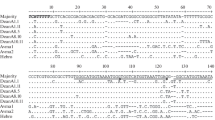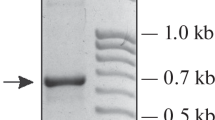Abstract
For studying the molecular organization of the genomic region coding for 5S rRNA in the diploid species Rosa rugosa, several 5S rDNA repeat units were cloned and sequenced. An analysis of the obtained sequences revealed that in the genome only one length variant of the 5S rDNA repeated unit is present that contains intact promoter elements in the intergenic spacer (IGS) and appears to be transcriptionally active. In addition, a limited number of 5S rDNA pseudogenes were detected with a complete loss of the IGS and a portion of the coding region. The high level of sequence similarity (from 93.7 to 97.5%), revealed by comparing the IGS of the major 5S rDNA variants of East Asian R. rugosa and North American R. nitida, indicates a relatively recent divergence of these species.
Similar content being viewed by others
References
Volkov, R.A., Zanke, C., Panchuk, I.I., and Hemleben, V., Molecular evolution of 5S rDNA of Solanum species (sect. Petota): application for molecular phylogeny and breeding, Theor. Appl. Genet., 2001, vol. 103, pp. 1273–1282.
Komarova, N.Y., Grimm, G.W., Hemleben, V., and Volkov, R.A., Molecular evolution of 35S rDNA and taxonomic status of Lycopersicon within Solanum sect. Petota, Plant. Syst. Evol., 2008, vol. 276, nos. 1/2, pp. 59–71.
Goncharov, N.P., Golovnina, K.A., and Kondratenko, E.Y., Taxonomy and molecular phylogeny of natural and artificial wheat species, Breed. Sci., 2009, vol. 59, pp. 492–498.
Martinez-Azorin, M., Crespo, M., Juan, A., and Fay, M., Molecular phylogenetics of subfamily Ornithogaloideae (Hyacinthaceae) based on nuclear and plastid DNA regions, including a new taxonomic arrangement, Ann. Bot., 2010, vol. 107, pp. 1–37.
Shulaev, V., Korban, S., Sosinski, B., et al., Multiple models for Rosaceae genomics, Plant Physiol., 2008, vol. 147, pp. 985–1003.
Volkov, R.A., Panchuk, I.I., Borisjuk, L.G., and Borisjuk, M.V., Plant rDNA: organization, evolution, and use, Cytol. Genet., 2003, vol. 37, no. 1, pp. 68–72.
Blattner, F.E., Progress in phylogenetic analysis and a new infrageneric classification of the barley genus Hodeum (Poaceae; Triticeae), Breed. Sci., 2009, vol. 59, pp. 471–480.
Volkov, R.A., Kozeretska, I.A., Kyryachenko, S.S., et al., Molecular evolution and variability of ITS1-ITS2 in populations of Deschampsia Antarctica from two regions of the maritime Antarctic, Pol. Sci., 2010, vol. 4, no. 3, pp. 469–478.
Wisseman, V., The genus Rosa (Rosoideae, Rosaceae) revisited: molecular analysis of nrITS-1 and atpB-rbcL intergenic spacer (IGS) versus conventional taxonomy, Bot. J. Linn. Soc., 2005, vol. 147, pp. 275–290.
Grimm, G.W. and Denk, T., The reticulate origin of modern plane trees (Platanus, Platanaceae): a nuclear marker puzzle, Taxon, 2010, vol. 59, no. 1, pp. 134–147.
Poczai, P. and Hyvonen, J., Nuclear ribosomal spacer regions in plant phylogenetics: problems and prospects, Mol. Biol. Rep., 2010, vol. 37, pp. 1897–1912.
Denk, T. and Grimm, G., The oaks of Western Eurasia: traditional classifications and evidence form two nuclear markers, Taxon, 2010, vol. 59, pp. 351–366.
Cloix, C., Tutois, S., Mathieu, O., et al., Analysis of 5S rDNA arrays in Arabidopsis thaliana: physical mapping and chromosome-specific polymorphisms, Genome Res., 2000, vol. 10, pp. 679–690.
Coen, E.S., Thoday, J.M., and Dover, G., Rate of turnover of structural variants in the rDNA gene family of Drosophila melanogaster, Nature, 1982, vol. 295, no. 5850, pp. 564–568.
Fulnecek, J., Lim, K.Y., Leitch, A.R., et al., Evolution and structure of 5S rDNA loci in allotetraploid Nicotiana tabacum and its putative parental species, Heredity, 2002, vol. 88, pp. 19–25.
Lim, K.Y., Werlemark, G., Matyasek, R., et al., Evolutionary implication of permanent odd polyploidy in the stable sexual, pentaploid of Rosa canina L., Heredity, 2005, vol. 94, pp. 501–506.
Tynkevich, Yu.O., Serbenyuk, M.P., and Volkov, R.A., Polymorphism of 5S rDNA of species of the genus Rosa L., Nauk. Visn. Cherniv. Univ., 2009, no. 455, pp. 142–144.
Tynkevich, Yu.O. and Volkov, R.A., Structural organization of 5S ribosomal DNK of Rosa nitida Wild, Visn. Ukr. Tovar. Genet. Selekts., 2011, vol. 9, no. 2, pp. 276–282.
Sambrook, J., Fritsch, E., and Maniatis, T., Molecular Cloning, Cold Spring Harbor, New York: Cold Spring Harbor Laboratory, 1989.
Panchuk, I.I. and Volkov, R.A., A Practical Course in Molecular Genetics, Chernivtsi: Ruta, 2007.
DNASTAR, 1998. MegAlign 3.18 Edit. Software distributed by DNASTAR Inc., Madison, WI, USA.
Higgins, D.H., Bleasby, A.J., and Fuchs, R., CLUSTAL V: improved software for multiple sequence alignment, Bioinformatics, 1992, vol. 8, pp. 189–191.
Altschul, S.F., Madden, T.L., Schaffer, A.A., et al., Gapped BLAST and psiBLAST: a new generation of protein database search programs, Nucleic Acids Res., 1997, vol. 25, pp. 3389–3402.
Singh, D. and Ahuja, P.S., 5S rDNA gene diversity in tea (Camellia sinensis (L.) O. Kuntze) and its use for variety identification, Genome, 2006, vol. 49, pp. 91–96.
Cherevatov, O.V. and Volkov, R.A., Organization of 5S ribosomal DNA of Melitaea trivia, Cytol. Genet., 2011, vol. 45, no. 2, pp. 115–120.
Douet, J. and Tourmente, S., Transcription of the 5S rRNA heterochromatic genes is epigenetically controlled in Arabidopsis thaliana and Xenopus laevis, Heredity, 2007, vol. 99, pp. 5–13.
Suzuki, H., Moriwaki, K., and Sakura, S., Sequences and evolutionary analysis of mouse 5S rDNAs, Mol. Biol. Evol., 1994, vol. 11, pp. 704–710.
Takahata, N. and Kumura, M., A model of evolutionary base substitutions and its application with special reference to rapid change of pseudogenes, Genetics, 1981, vol. 98, pp. 641–657.
Author information
Authors and Affiliations
Corresponding author
Additional information
Original Ukrainian Text © Y.O. Tynkevich, R.A. Volkov, 2014, published in Tsitologiya i Genetika, 2014, Vol. 48, No. 1, pp. 3–9.
About this article
Cite this article
Tynkevich, Y.O., Volkov, R.A. Structural organization of 5S ribosomal DNA in Rosa rugosa . Cytol. Genet. 48, 1–6 (2014). https://doi.org/10.3103/S0095452714010095
Received:
Published:
Issue Date:
DOI: https://doi.org/10.3103/S0095452714010095




